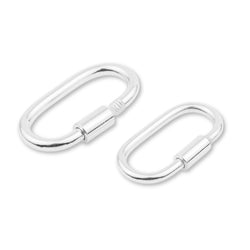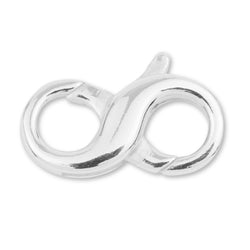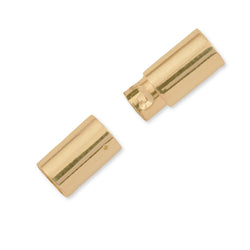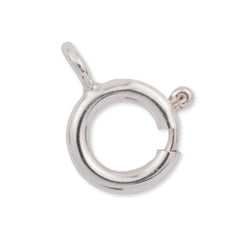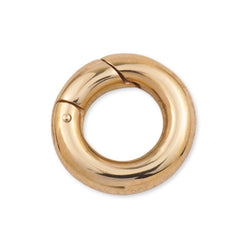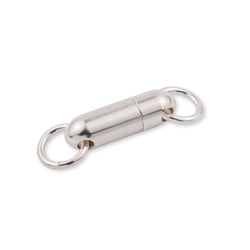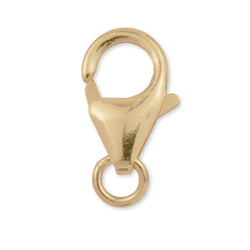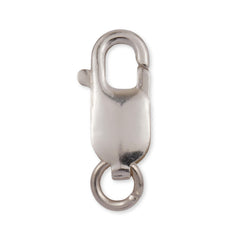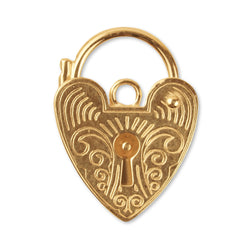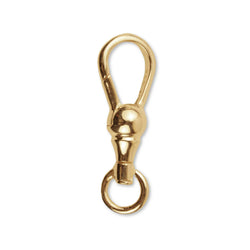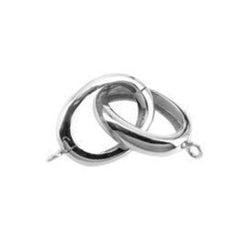Verschlüsse und Verbindungsstücke
Verschlüsse für die Schmuckherstellung
Unsere Schmuckverschlüsse und Verbinder sind in hochwertigen Gold- und Silberlegierungen erhältlich. Wählen Sie aus 9-karätigem, 14-karätigem und 18-karätigem Gold in den Farbtönen Gelb, Weiß und Rosé für einen Hauch von Luxus oder entscheiden Sie sich für die zeitlose Ausstrahlung von Sterlingsilber. Jedes Material bietet seinen einzigartigen Charme und seine Haltbarkeit, perfekt für verschiedene Schmuckdesigns.
Häufig gestellte Fragen
Schmuckverschlüsse gibt es in verschiedenen Designs und Namen, jeder mit einzigartigen Eigenschaften und Ästhetik.
Zu den gängigen Typen gehören Karabinerverschlüsse, Federringverschlüsse, Knebelverschlüsse, Magnetverschlüsse und Papageienverschlüsse.
Der spezifische Name spiegelt häufig das Design oder die Funktionalität der Schließe wider. Eine vollständige Liste finden Sie weiter unten.
Es gibt verschiedene Arten von Schmuckverschlüssen, die jeweils einzigartige funktionale und ästhetische Eigenschaften bieten:
- Karabinerverschlüsse : Diese Verschlüsse ähneln einem Karabiner, sind sicher und werden häufig in Halsketten und Armbändern verwendet.
- Federringverschlüsse : Kreisförmige Verschlüsse, die sich mit einem Federmechanismus öffnen und schließen lassen und für eine Vielzahl von Schmuckstücken geeignet sind.
- Knebelverschlüsse : Sie bestehen aus einer Stange, die durch einen Ring passt (Knebelverschluss), sind einfach zu verwenden und verleihen einen dekorativen Touch.
- Magnetverschlüsse : Verwenden Sie Magnete zum Verschließen, was eine einfache Handhabung, aber möglicherweise weniger Sicherheit bietet.
- Kastenverschlüsse : Bestehen aus einem Kasten und einem Zungenstück, das einrastet und häufig bei elegantem Schmuck verwendet wird.
- Papageienverschlüsse : Ähnlich wie Karabinerverschlüsse, jedoch mit einer abgerundeteren Papageienform.
- Bajonettverschlüsse : Verfügen über einen zylindrischen Verschlussmechanismus, ideal für elegante, moderne Designs.
- Drehverschlüsse : Ermöglichen das Drehen oder Schwenken des Schmuckstücks und verhindern so ein Verheddern.
- Vorhängeschloss-Verschlüsse : Diese Verschlüsse haben die Form eines kleinen Vorhängeschlosses und bieten sowohl Sicherheit als auch dekorative Elemente.
- Haken- und Ösenverschlüsse : Einfache Verschlüsse, bei denen ein Haken in eine Öse oder Schlaufe einrastet. Einfach zu verwenden und oft in handgefertigtem Schmuck zu finden.
- Ineinandergreifende ovale Verschlüsse : Bestehen aus zwei ovalen Teilen, die ineinandergreifen und einen sicheren und ästhetischen Verschluss bieten.
- Endlose Kreisverschlüsse : Bilden im geschlossenen Zustand einen durchgehenden Kreis und bieten einen nahtlosen und eleganten Look.
Als stärkster Schmuckverschluss gilt im Allgemeinen der Karabinerverschluss, da er robust und sicher ist.
Karabinerverschlüsse sind federbelastet und selbstschließend und bieten so einen zuverlässigen Halt, bei dem es weniger wahrscheinlich ist, dass sie sich versehentlich öffnen.
Sie werden häufig für eine Vielzahl von Schmuckarten verwendet, von leichten bis hin zu schwereren Stücken.
Weitere starke Verschlüsse sind der Kastenverschluss und der Bajonettverschluss.
Lobster clasps and parrot clasps are among the most durable options for bracelets. These clasps provide secure closures and withstand daily wear, making them ideal for both casual and high-end jewellery pieces. Their robust construction ensures longevity, even with frequent use.
Choose a clasp that complements the style and weight of your jewellery. For delicate designs, opt for spring ring clasps or small lobster clasps. For heavier pieces, consider using box clasps or toggle clasps for added security. Match the metal of the clasp with the jewellery to maintain a cohesive look.
The most popular clasps include lobster clasps, spring ring clasps, parrot clasps, and padlock clasps. These clasps are widely used due to their ease of use, reliability, and versatility in various jewellery designs, from bracelets to necklaces.
Lobster clasps are generally more secure and easier to operate than spring ring clasps. They feature a lever that opens and closes the clasp, providing a more substantial closure. Spring ring clasps are smaller and circular, making them ideal for lighter jewellery, but they may be more challenging to fasten.
To attach a clasp, use a jump ring to connect the clasp to the end of the chain or jewellery piece. Open the jump ring with pliers, slide it through the loop on the clasp and the chain, then close the jump ring securely. For added durability, consider soldering the jump ring closed.
Magnetic clasps are best suited for lightweight to medium-weight jewellery. While they offer convenience, they may not provide the necessary security for heavy jewellery pieces. For heavier designs, consider using lobster or padlock clasps for a more secure closure.
Sterling Silver clasps offer durability, affordability, and a timeless aesthetic that complements a wide range of designs. They are hypoallergenic and tarnish-resistant when properly cared for, making them a popular choice in both modern and classic jewellery.
Gold clasps, particularly those made from higher karat gold, are durable and resistant to tarnishing. However, sterling silver clasps are also highly durable and can withstand daily wear. The choice between the two often depends on the design and desired aesthetic of the jewellery.
To maintain the quality of gold clasps, regularly clean them with a soft cloth to remove oils and dirt. Store gold jewellery in a separate compartment or pouch to prevent scratches.
Parrot clasps, spring ring clasps and lobster clasps are among the best options for making a secure necklace. These clasps provide a strong closure that reduces the risk of accidental opening, ensuring that the necklace stays in place, even with daily wear.
Yes, lobster clasps are an excellent choice for handmade jewellery. They are versatile, secure, and easy to use, making them suitable for various types of handmade pieces, including necklaces and bracelets.
Choose between 9ct, 14ct, and 18ct gold clasps based on your design’s aesthetic and budget. 9ct gold is more durable and affordable, while 18ct gold offers a richer colour and higher purity. 14ct gold provides a balance between durability and luxury, making it a popular choice.
High-quality jewellery clasps should be made from durable materials, provide a secure closure, and have a smooth, polished finish. They should be easy to operate and strong enough to withstand regular use without compromising the security of the jewellery piece.
Parrot clasps are similar to lobster clasps but have a more rounded, parrot-like shape. Both provide secure closures, but lobster clasps are more common and are often preferred for their ease of use and reliability.
Gold clasps add a luxurious finish to jewellery pieces and are highly resistant to tarnishing. They enhance the overall value of the jewellery and are suitable for both everyday wear and special occasions. Gold clasps also offer hypoallergenic properties, making them safe for sensitive skin.
Incorporate clasps into custom jewellery designs by selecting a clasp that complements the metal and style of the piece. Ensure the clasp is proportionate to the jewellery and provides a secure closure. Customisation options, such as engraving, can add a personal touch to the clasp.
Yes, padlock clasps can be used in custom jewellery designs. They add a decorative and functional element, making them ideal for both vintage-inspired and modern pieces. Padlock clasps provide a unique and secure closure option for necklaces and bracelets.
To ensure a clasp is secure on a heavy necklace, choose a durable clasp such as a large spring ring or lobster clasp. Ensure the clasp is properly attached using strong jump rings, and consider soldering the connections for added security. Regularly check the clasp for signs of wear.
Yes, mixing metals such as sterling silver and gold in jewellery designs can create a unique and modern look. When using clasps, ensure that the metals complement each other and that the design remains cohesive. Mixing metals adds visual interest and versatility to your pieces.
For lightweight necklaces, opt for smaller, more delicate clasps such as spring ring clasps or small lobster clasps. These clasps provide a secure closure without overwhelming the design. Ensure the clasp matches the overall aesthetic of the necklace.
To ensure a comfortable fit, choose clasps that are appropriately sized for the jewellery piece and do not add bulk. Clasps should be easy to operate and should not irritate the skin. Ensure the clasp is securely attached to prevent discomfort during wear.
Yes, clasps are essential components in DIY jewellery projects. They are easy to work with and available in various styles, making them suitable for both beginners and experienced crafters. With the right tools, you can create custom jewellery that reflects your personal style.
Yes, you can use clasps to convert a necklace into a bracelet by adding additional clasps or chain segments to adjust the length. This allows you to create versatile jewellery pieces that can be worn in different ways, offering multiple styling options.
Clasps enhance the functionality of jewellery by providing secure closures that keep the pieces in place. They also allow for easy wear and removal of jewellery, making them essential components in both everyday and special occasion pieces. High-quality clasps contribute to the overall durability and usability of the jewellery.

